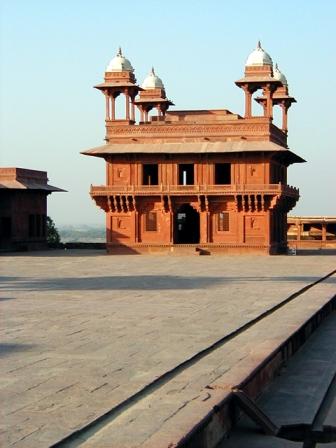Contribute
| South Asian Art - In Memory Of Prashant H. Fadia |
Ranjani Saigal
03/06/2008
The Aushotosh Gowarikar period film, Jodha Akbar has succeeded in creating curiosity about the life of Emperor Akbar and his contributions to India. This great emperor was known for his tolerance and respect for all religions and seems to have tried to even create a new religion “Din-i-ilahi†which draws from the greatness of different religions. Perhaps this tolerance was in part the secret to his success in creating a great empire. Unfortunately not all the Mughal leaders followed in his footsteps and unfortunately the last of the successful Mughal Emperors, Aurangazeb was quite a radical fundamentalist.
Akbar’s passion for art and architecture led him to build great monuments. His biography - the Akbarnama is one of the most beautifully illustrated historical records. History reports that despite growing up in a high profile Muslim household where education was considered very important, he was unable to read. Historians have argued that he perhaps had some learning disability, perhaps dyslexia. People with dyslexia have an in-built aptitude for two-dimensional visual representation and three-dimensional constructs.
Perhaps this is what drove Akbar towards the arts.
Art and religion both strive towards the understanding the Absolute and also learning the meaning of existence. Thus historically arts have had a close connection to religious institution and have had a give and take relationship with religion, where the sculptures and the monuments dedicated to spiritual pursuits have been created by the artist but guided and inspired by religious leaders. The monuments and sculptures have gained a spot that is much greater than both the artist and the religious leaders.
The fact that Akbar invited artists of different religious backgrounds to create his monuments stands as testimony to his religious tolerance. Thus one of his greatest forts, the Fatehpur-Sikhri is a beautiful blend of Hindu and Muslim art and architecture. Akbar intended his city of Fatehpur Sikri to serve as an imperial capital, an alternate to the overcrowded city of Agra. Completed in 1585, the city was abandoned after only 15 years because of insufficient water supply. Thereafter it remained deserted, and almost perfectly preserved. Here the early Mughal fusion of Hindu and Muslim architectural styles was embodied in spacious courtyards, wide palaces, and open pavilions, quarried from the local sandstone and cooled by numerous water channels, ponds, and tanks.
The fort consists of the following buildings
Naubat Khana – Drum house: near the entry, where important arrivals are announced.
Diwan-i-Am – Hall of Public Audience: a building typology found in many Mughal cities where the ruler meets the general public. In this case it is a pavilion like multi-bayed rectangular structure fronting a large open space.
Diwan-i-Khas – Hall of Private Audience: famous for its central pillar with thirty-six voluted brackets supporting a circular platform for Akbar.
Raja Birbal's house - the house of Akbar's favorite minister, who was a Hindu. Notable features of the building are the horizontal sloping sunshades or chajjas and the brackets which support them.
Jodhabai's palace - The building shows Gujarati influence and is built around a courtyard, with special care being taken to ensure privacy.
Pachisi Court - a square marked out as a large sized board game (modern day Ludo) where live coins- people- participated.
Char Chaman Tank - a tank with a central platform and four bridges leading up to it.
Panch Mahal - A five-storied palatial structure. The bottom floor has 176 intricately carved columns.
Buland Darwaza – the 'Gate of Magnificence': one of the gateways to the Jami masjid, a stupendous piece of architecture from the outside making a transition to a human scale in the inside.
Jama Masjid - the mosque, built in the manner of Indian mosques, with liwans (aisles) around a central courtyard. A distinguishing feature is the row of chhatris (small domed pavilions) over the sanctuary.
Tomb of Salim Chisti: a white marble encased tomb within the Jama mosque's courtyard
The central pillar of the Diwan-i-khas resembles the pillars of a Hindu temple. Details of carvings on several buildings also point to a collaborative approach to architecture. In the next article we will describe Mughal paintings and the continuation of Mughal art and architecture in the post-Akbar era.
You may also access this article through our web-site http://www.lokvani.com/
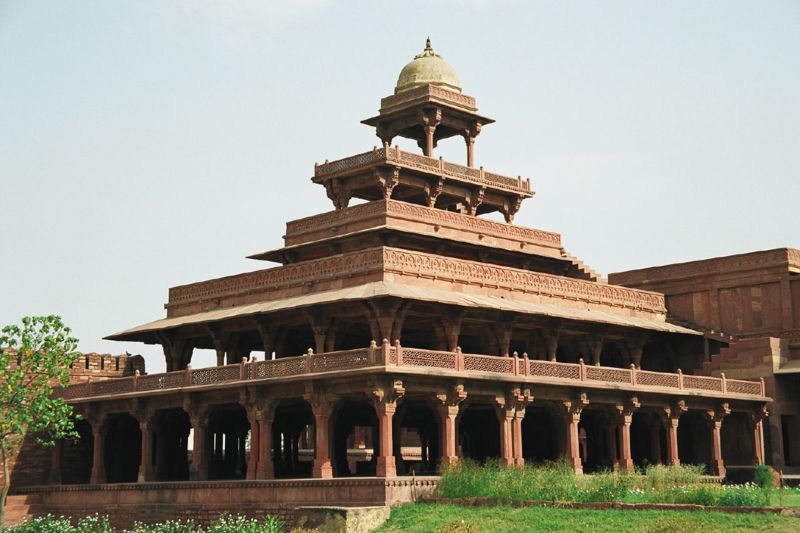
Panch Mahal
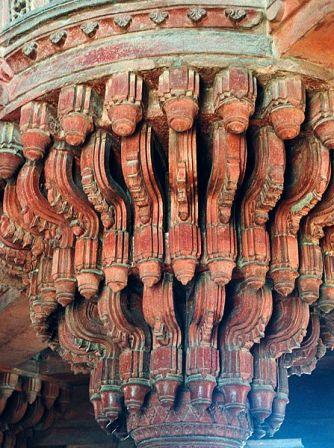
Pillar Carving
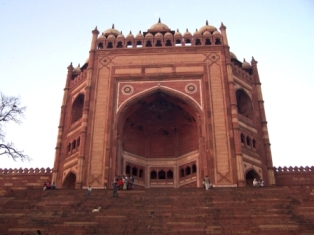
Bulund Darwaza
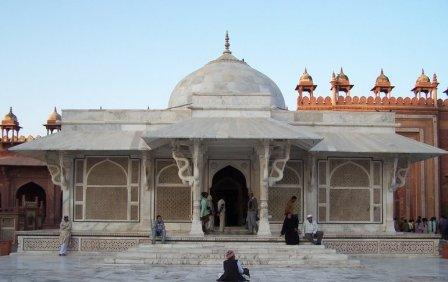
Tomb of Salim Chisti
